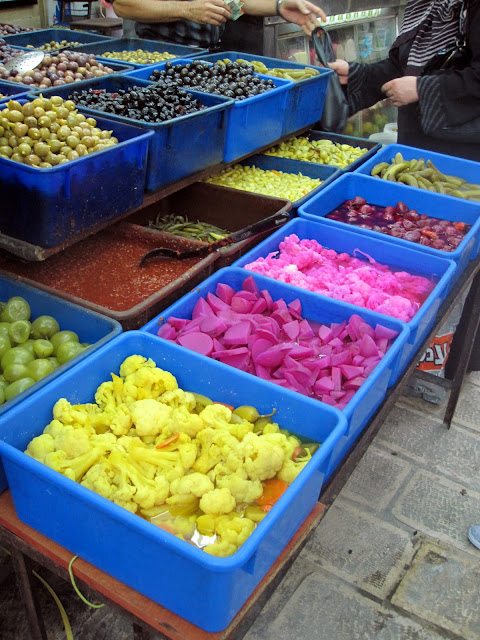 |
| The wall ın Jerusalem dıvıdıng the West Bank from Israel |
We were out bright and early the next morning having sailed south from Haifa , past Tel Aviv to the main port of Israel at Ashdod Jerusalem Israel and the West Bank .
 |
| Vıew from Mt of Olıves wıth Jewısh Cemetery ın foreground |
Before entering Jerusalem we stopped at the Mt. of Olives Mt. Zion
 |
| Gethsemane place of Jesus prayıng |
We started with a visit to the Basilica of Agony built over the, “the rock” where Jesus prayed before he was arrested. The church is recent and is a very solemn and quiet place, in contrast to all the other places we visited which are noisy, crowded and far from feeling sacred or holy. The olive garden next to the church (no relation to an Italian restaurant!), where the disciples slept while Jesus prayed and where Judas identified Jesus, boasts one tree that is 900 years old.
 |
| Colorful array of foods ın the Arab market |
We popped back into our van, drove closer to the old city, leaving the van at a convenient car wash/parking lot near the famous Damascus Gate. Soon we were immersed in the very busy and noisy Arab market with its stalls selling everything imaginable, including these colorful bins of olives and vegetables. Women in burkas pawing through bins of underwear were an unusual sight. The market continued through an arch into the Jewish quarter, where the chaos quieted, order reigned, and cleanliness was welcomed. Two very different cultures presenting their wares in two very different ways separated by only an arch. The Jewish quarter was destroyed when Jordan occupied Jerusalem
We walked along the Via Dolorosa stopping at the Stations of the Cross until we reached the Church of the Sepulcher, a huge structure with many, many chapels. The first stop was the Coptic chapel, where we crawled down a tunnel into an ancient cistern. Oh the joys of traveling in a small tour group of 6! Water is and was a problem. Israel Dead Sea . Just outside this Coptic Church, whose followers are Egyptian, Joe explained that six different Christian churches struggle to control the site believed to be the place of the crucifixion and burial of Jesus: Coptic, Roman Catholic, Greek Orthodox, Jacobeans (Syrian), Armenian, and Ethiopian (land of the Queen of Sheba). Each has followers who reside here and have conducted turf wars over the years. Even today they continue to act in a most un-Christian like fashion. The problem of who would control the key to the church was settled by picking a Muslim family to lock and unlock the church – and pass the key down from generation to generation. We climbed stairs to the rock where the cross was placed. About 100 feet away from the crucifixion is a chapel built over Jesus’ tomb. While we were there, the priests from each church took turns entering the large chapel, swinging their incense and then retreating to their individual chapels.
 |
| Dad gets a new hat |
The Western Wall or Wailing Wall of the city was truly memorable. Men are separated from the women by a screen. Jon donned the loaner yamika while I covered my head with a shawl. The women, after quietly praying, backed away from the wall in small steps and bowing all the way for several yards before turning to leave.
 |
Entering Bethlehem. Very prison lıke |
Then the really interesting part of the afternoon began. Our Israeli guide is not allowed into Bethlehem which is in the West Bank and governed by the Palestinian Authority. Bethlehem is essentially a suburb of Jerusalem Bethlehem
 |
| Birthplace of Jesus ın Bethlehem |
Our guide said, “Follow me, please”. We entered the EXIT area just outside the small room, where our guide spoke to the guards. We were allowed to access the room immediately, two at a time, walking down a stairway against the exiting traffic. We took a quick look around and snapped a picture. We learned later that the wait in the regular line was more than two hours. Again, it was nice to be in a small group with a “fixer”.
After the church we walked over to a small souvenir shop with our taxi driver. Our guide disappeared once we got to the shop— I guess he didn’t expect tips. As it was beginning to get dark, we were anxious to be on our way. A new 2nd cab was hailed for 3 of us and we just hoped we would get to the RIGHT meeting point with Joe, as we still had more than an hour’s ride ahead of us back to the ship. After one wrong turn, we were soon on our way out of the Bethlehem
One final comment about Jerusalem Bethlehem
No comments:
Post a Comment